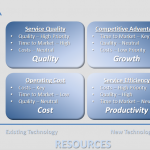Starting any project is daunting and Business Service Management as an initiative is often thought of as big, hard and complicated. My personal opinion is that stems from the fact that it cuts horizontally across the data center and does not reside in one sphere of influence. However, as a long time product marketing / product manager I find it can be quite simple. One service at a time, one service team at a time approach rather than boiling the ocean all at once. Let’s start at the top, the service, and work our way down and back up again in a series of posts.
Start at the top, the service(s) and take them one at a time. My usual advice is to pick 2, 1 that is absolutely mission critical to the organization and 1 that is back-office and well known from a configuration and management standpoint. What, select my most critical? Yes, this will have the biggest bang for the buck in making strides with the business with a higher quality of service and fast return. Selecting something you know well insures you know the data is fairly accurate while you learn the process, but likely will not score points with the business.
The first thing to do is identify the services and categorize them – not all services are created equal and thus should not be managed as such. Here’s what I mean,
 Create 4 simple classifications:
Create 4 simple classifications:
- Growth – Services that drive and support revenue growth. New and current services that differentiate your company in the market.
- Quality- Services that drive quality of the customer experience and customer retention in the market.
- Productivity – Services that are must have and more inward facing automating and driving efficiencies in the organization.
- Cost – Services that are must have, not differentiated in the market and must just operate as efficiently as possible.
The chart illustrates the typical key drivers for each category of service. By first identifying your services and making a simple judgment, it will aid in determining how you will manage these services and where the priorities lie. Simply, above the line are your Business Value, strategic services that touch your external customers and below the line are your Business Cost, operational services that are required to operate efficiently.
This classification will guide the definition of your service levels, priorities, DR and responsiveness strategies. The approach is a little top down and a little bottom up to meet in the middle. Identifying and classifying the services top down will define the rules of engagement with the business and the bottom up maps what you have and how the infrastructure components are related. The connection in the middle is the meeting of the infrastructure with the logical use of the infrastructure. In this post I’m concentrating on the top first.
Some organizations delineate this as 2 functions: 1) IT and technical configurations and 2) Service delivery and logical configurations. We will speak in terms of one view that turns the technology silos into services, balancing the technical management requirements with business service quality requirements. Yes, technical and logical definitions are required, but what I’m suggesting is that they will meet in the middle leveraging the same data and information for multiple purposes keeping the business and IT in synch with one another.
I had the opportunity to facilitate a half day workshop not too long ago where this division and 2 projects existed. The first was an operational, technical CMDB project and the second was a service delivery governance project. It took a little time, but about half way through the session the light bulb went on. We were talking about the same CMDB project, but were layering in the availability/performance/management aspect to give it life and finally the rules of engagement from the business regarding priority, etc. What comes as second nature to me, is sometimes lost in the silos we work in as IT organizations and just takes a little bit of a different approach.
Ok, this is step one…I encourage the service delivery folks to find their configuration counterparts and vice versa. Next post, the top down modeling……



